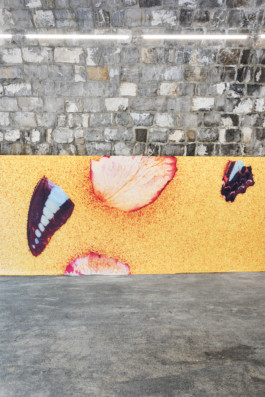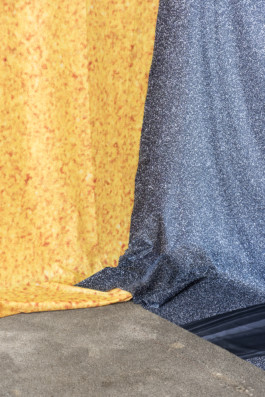



















Invited by Charlotte Sarrazin
With FREEZE, Berlin-based artist Marius Glauer creates a site-specific installation with series of photographic works exploring the boundaries and conversions of reality and representation. Through hyper-realistic assemblages, he reimagines industrially manufactured materials, flowers and found objects, arranging them in performative and sculptural formations to evoke poetic worlds of illusion and still-life scenes seemingly fallen out of time. For this show, the artist explored Gustav Klimt’s Beethoven Frieze, created for the XIVth exhibition of the Association of Visual Artists Vienna Secession, which was held in 1902, and conceived a new series of photographic works and a frieze-like scenography along the given walls, evoking a familiar yet unconventional imagery of calculated resonance.
Marius Glauer’s installation, specially tailored to the extraordinary exhibition site beneath one of Lausanne’s historical bridges, utilizes sublimation prints on voile as priming coats on the walls, embracing the photographic image cycle seamlessly. By constructing a portal into the (re-)enchanted realm of art, Glauer invites us to forge new associations between humanity and the world. His work often challenges our expectations, simultaneously fulfilling and subverting them. Surfaces within the installation are disrupted by drips of condensation, fogs of glitter, fragments of butterflies or flowers, and flashes of light, purposefully blurring the boundaries between objects, surroundings, and our perception, merging with the architectural space itself. Connections between individual pieces of the different groups of works pose a subtle question: To what extent do truth and beauty remain valid in contemporary visual experiences?
Photographs by Remy Ugarte Vallejos
Invited by Charlotte Sarrazin
With FREEZE, Berlin-based artist Marius Glauer creates a site-specific installation with series of photographic works exploring the boundaries and conversions of reality and representation. Through hyper-realistic assemblages, he reimagines industrially manufactured materials, flowers and found objects, arranging them in performative and sculptural formations to evoke poetic worlds of illusion and still-life scenes seemingly fallen out of time. For this show, the artist explored Gustav Klimt’s Beethoven Frieze, created for the XIVth exhibition of the Association of Visual Artists Vienna Secession, which was held in 1902, and conceived a new series of photographic works and a frieze-like scenography along the given walls, evoking a familiar yet unconventional imagery of calculated resonance.
Marius Glauer’s installation, specially tailored to the extraordinary exhibition site beneath one of Lausanne’s historical bridges, utilizes sublimation prints on voile as priming coats on the walls, embracing the photographic image cycle seamlessly. By constructing a portal into the (re-)enchanted realm of art, Glauer invites us to forge new associations between humanity and the world. His work often challenges our expectations, simultaneously fulfilling and subverting them. Surfaces within the installation are disrupted by drips of condensation, fogs of glitter, fragments of butterflies or flowers, and flashes of light, purposefully blurring the boundaries between objects, surroundings, and our perception, merging with the architectural space itself. Connections between individual pieces of the different groups of works pose a subtle question: To what extent do truth and beauty remain valid in contemporary visual experiences?
Photographs by Remy Ugarte Vallejos



















